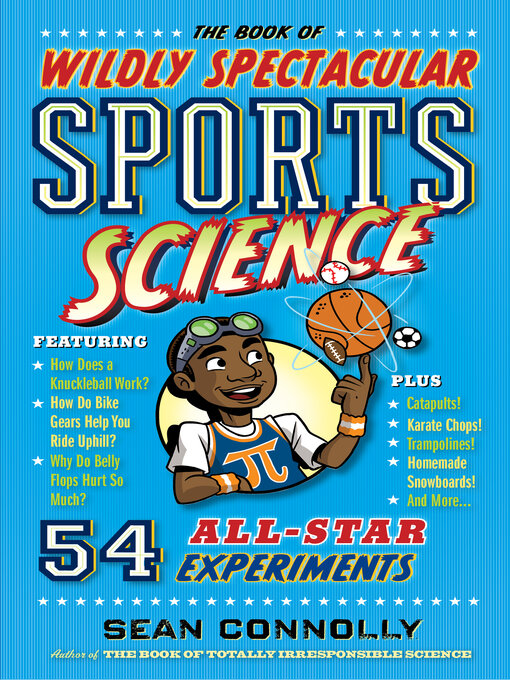Here are 54 all-star experiments that demonstrate the scientific principles powering a wide variety of sports and activities—and offer insights that can help you improve your own athletic skills. How does a black belt karate chop her way through a stack of bricks? Use Popsicle sticks to understand why it’s possible and learn the role played by Newton’s second law of motion. Does LeBron James really float through the air on the way to a dunk? Use a tennis ball, a paperback book, and the help of a friend to understand the science of momentum and the real meaning of hang time. Using common household objects, each project includes step-by-step instructions, tips, and a detailed explanation of how and why the experiment worked. It’s a win-win.
The thrill of victory, the agony of defeat—it’s all in the science.
-
Creators
-
Series
-
Publisher
-
Release date
November 29, 2016 -
Formats
-
OverDrive Read
- ISBN: 9780761189770
- File size: 22409 KB
-
EPUB ebook
- ISBN: 9780761189770
- File size: 22409 KB
-
-
Languages
- English
-
Levels
- Lexile® Measure: 1020
- Text Difficulty: 6-8
-
Reviews
-
Publisher's Weekly
September 12, 2016
In the fourth title in the series that began with The Book of Totally Irresponsible Science, Connolly gets at the science behind sports with 54 experiments designed to provide answers to questions like “What Makes a Frisbee Fly?” while introducing such concepts as lift, drag, propulsion, friction, kinetic energy, and mass. The experiments are a mix of physically active (using a playground seesaw to explore the torque involved in a snowboarder’s flip) and rainy day friendly (a pen, putty, and DVD help demonstrate the angular momentum of a football spiral pass). The chatty tone, clear scientific explanations, and broad range of athletics discussed mean there’s something here for just about every kind of sports fan. Ages 9–up. -
School Library Journal
December 1, 2016
Gr 4 Up-Connolly's appealing collection of hands-on experiments illustrates many of the science principles at work in athletics. The work consists of seven well-organized chapters of clearly described activities. The format for each experiment is consistent, beginning with a heading that notes the specific sport involved and estimated amount of time needed to complete the project. The smooth writing style and engaging content enliven the learning process and will even enlist the participation of those not scientifically inclined. The cartoonish artwork also adds touches of humor. Each experiment is wrapped up with a concluding explanatory section discussing the science involved and how it relates to a given sport. Examples of science concepts covered include Boyle's law, centripetal force, conservation of energy, kinetic energy, Newton's laws of motion, and surface tension. Students can conduct these experiments on their own. However, some activities do require adult help or supervision (safety cautions are provided throughout). Teachers, too, will find a wealth of material to enhance classroom lessons or physical education classes. VERDICT A worthy purchase for all libraries, especially for schools.-Lynn Vanca, Freelance Librarian, Akron, OH
Copyright 2016 School Library Journal, LLC Used with permission.
-
Booklist
November 15, 2016
Grades 4-6 Here the author of several volumes with rousing titles like The Book of Potentially Catastrophic Science (2010) offers 54 quick-and-easy, small-scale demonstrations of various physical laws and principles linked (sometimes tenuously) to sports. Each entry features a warning note, but aside from jumping off a chair or catching a falling egg, the activities are low risk. They range from simply turning on a faucet and observing that the stream narrows (which represents Bernoulli's principle) to constructing a rubber band trebuchet (actually a catapult) to show torque and momentum in action. Except, perhaps, for the brave adult, required for one set-up involving a playground swing, and a cinder block, the materials and components are common household items. The demos open with examples of historical athletic feats to get young experimenters in the mood, and then go on to lists of materials, step-by-step directions with line-drawn illustrations, and, finally, clear explanations of the relevant physics. Along with being fun, most of these could be developed into presentable elementary science projects.(Reprinted with permission of Booklist, copyright 2016, American Library Association.)
-
Formats
- OverDrive Read
- EPUB ebook
Languages
- English
Levels
- Lexile® Measure:1020
- Text Difficulty:6-8
Loading
Why is availability limited?
×Availability can change throughout the month based on the library's budget. You can still place a hold on the title, and your hold will be automatically filled as soon as the title is available again.
The Kindle Book format for this title is not supported on:
×Read-along ebook
×The OverDrive Read format of this ebook has professional narration that plays while you read in your browser. Learn more here.



